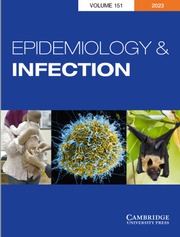Article contents
House Flies as Carriers of Disease
Published online by Cambridge University Press: 15 May 2009
Extract
Core share and HTML view are not available for this content. However, as you have access to this content, a full PDF is available via the ‘Save PDF’ action button.
All observers agree that Musca domestica comprises over 90 percent. of the flies found in houses; my own observations show 97 percent. M. domestica is most easily distinguished by the venation of its wings, the fourth vein being bent up at an angle, and by the four longitudinal black stripes on the thorax. It is thus easily distinguished from Homolomyia canicularis, another somewhat smaller fly which frequents houses and forms the bulk of the remaining 3—10 per cent.
- Type
- Research Article
- Information
- Copyright
- Copyright © Cambridge University Press 1909
References
Chantemesse, and Borel, (1905). [Report of Meeting of Acad. of Med. of Paris.] Lancet, 11. 4th, p. 318.Google Scholar
Gleichen, and Keller, (1905)(1790). Geschichte der gemeinen Stubenfliege. Gleichen. Historie de la Mouche Commune de nos appartments. J. C. Keller. (Bound together.)Google Scholar
Hewitt, C.Gordon, (X. 1908). Biology of house-flies in relation to Publ. Health. Journ. Roy. Inst. Publ. Health, 10. 1908, also Monograph on M. domestica. Quart. Journ. of Microsc. Sci., Vol. LII. N.S.Google Scholar
Nash, J. T. C.. (1903). The seasonal incidence of Typhoid Fever and of Diarrhoea. Trans. Epidemiol. Soc., Vol. XXII. N.S.Google Scholar
Nash, J. T. C.. (1905). The Waste of Infant Life. Journ. Roy. San. Inst., Vol. XXVI. No. 9, pp. 495–498.Google Scholar
Newstead, R. (1907). The habits &c. of the common house-fly. Ann. of Trop. Med. and Parasit. Univ. of Liverpool, Vol. I. No. 4.Google Scholar
Nuttall, G. H. F.. (1899). On the Rôle of insects, arachinds and myriapods as carriers in the spread of bacterial and parasitic diseases of man and animals. A critical and historical study. Johns Hopkins Hosp. Reports, Vol. VIII.Google Scholar
Packard (1874). On the transformation of the common house-fly, &c. Proc. Boston Soc. of Nat. Hist., Vol. XVII. pp. 136–150.Google Scholar
- 5
- Cited by


